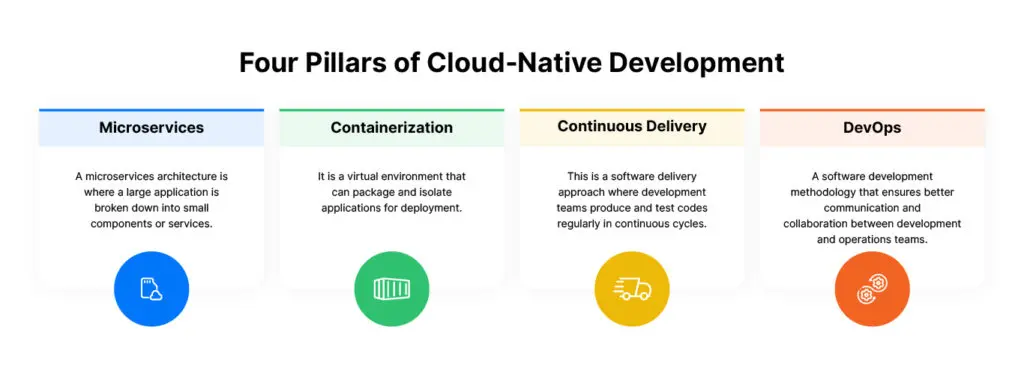Principles of DevOps and Cloud-Native Applications
The benefits of building an application native to the cloud is better resilience to prevent data loss, agility to meet the demands of increased traffic, operability from the inside of an application rather than externally, and visibility of all events that occur within a cloud environment. DevOps is the practice of continuously updating and operating an application over the span of its lifecycle. The implementation of both concepts together will see users benefiting from automation, cross-functional teams, and a better view of the developers’ end goals. These will be concepts to apply to the developers, dev tools, and process rather than to the application itself.
Underlying Necessary Changes
Cultural
This is the more complicated concept. Applications don’t necessarily need to be completely in the cloud to be cloud-native. There can still be some hybrid elements implemented into the application’s design and still be considered a cloud-centric design. How the DevOps cycle is then implemented to consider its cloud presence is something the developers will need to accommodate for. Everyone will need to be apprised of the appropriate objectives and the same set of tools.
Collaboration
Tying into the previous point, everyone needs to be collaborating to the same end. This will ideally result in a faster feedback loop between developers and the end users. In turn, this faster cycle will provide less time between major updates and action items for the business.
Technological
The development team will need to migrate off any other technologies relative to what the application requires. Having any superfluous components in the development process will slow down the time it takes to deploy.
How to Implement
Another thing to consider is that deploying natively to the cloud is very specific. It requires meeting the following set of criteria:
Microservice Patterns
Bigger applications can tolerate bigger workloads, but can also be more cumbersome as a result. To better compensate, they should be segmented into a series of smaller services that can be rearranged with some independence. To ensure they remain in line with other services, each should be interconnected with a single strong contract that still can be iterated on. In unison, these services will make up the application.
Containerization
Space is also a major concern. Be sure to bundle code as much as possible as it won’t necessarily impact the underlying system.
Container Orchestration
Ensuring these containers are properly coordinated is important. Furthermore, making coordination as simple as possible is just as critical if not more so. Having Kubernetes or another orchestration platform helps to simplify the details of computational, storage, or networking resources.

Declarative Communication Patterns
Developers need to standardize the communication model. Cloud-native applications can accomplish this through a network capable of delivering messages that will return success or failure. This moves the internal workings necessary to accomplish the application’s end functionality away from the application and to a remote API endpoint of the developers’ choice.
Abiding by 12-Factor App Principles
The Twelve Principles are best practices for web applications and software-as-a-service for developers to leverage better long-term growth, aid collaboration between developers, and minimize the damage done by code erosion. The principles are as follows:
-
- Codebase - Keep revisions and tracking for multiple deployments down to a singular repository.
- Dependencies - All dependencies should be declared, sparing no details.
- Config - Everything that is likely to differ at various stages of development, including resource handles, credentials to external services, and per-deployment values. The application must be able to be made open source currently without compromising any credentials
- Backing Services - Any external services the application needs to function on a normal basis should be treated as resources.
- Build, Release, Run - Keep the stages Separate. Ideally, at points where the code is compiled into an executable bundle, when the executable bundle is applied to an application’s config, and when the application is applied to an executable environment should all be kept separate from each other
- Process - Processes should be stateless and not share anything. Any data that does need to persist should be kept in a backing service like a database.
- Port Binding - Apps should be self-contained and not rely on runtime injection from a web server into the executable environment.
- Concurrency - Any app run is represented as processes. Workloads should be organized by process type.
- Disposability - Processes should be disposable and should be started or stopped at any time.
- Dev/Prod Parity - Applications should use the same backing services for both their development builds and their production builds for consistency.
- Logs - Treat logs as event streams instead to better observe app behavior.
- Admin Processes - Admin and management tasks should be run as one-off processes.
Automate CI/CD Pipelines
One benefit cloud-native applications can provide is the automation of the development cycle. Check out our article for more on CI/CD automation frameworks.
Make Health Checks Habitual
The application is actively telling the platform what state it is in, making monitoring system health significantly easier.
Telemetry Data
Latency, requests per minute, and other factors are needed to determine if a service is meeting the minimum required objectives. Inspect these values frequently.
Upkeep in the Cloud
Though many of the base concepts will continue to remain the same, development teams are naturally expected to adjust to the different technologies and tools. Cloud-native setups will now require a greater attention to detail and coordination between development team members. But with the changes comes various benefits that developers will find makes their jobs significantly easier.
